|
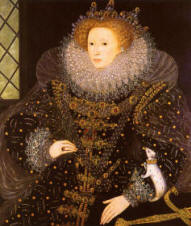
Elizabeth I 1533-1603
|
|
Image above:
Elizabeth I, Queen
of England. Note her pretty hands. |
Elizabeth I was
also called Good Queen Bess. Another nickname was The Virgin
Queen. She was Queen of England from 1558 to 1603.
As one of the most captivating rulers in history, Elizabeth came to
power at a time when women were expected not to participate in
public life.
Much like her father,
 Henry VIII,
she had great charisma. She also knew how to operate very
economically with the small budget she had at the beginning of her
reign. Henry VIII,
she had great charisma. She also knew how to operate very
economically with the small budget she had at the beginning of her
reign.
Elizabeth was courageous, intelligent, and insightful to human
nature. She carefully navigated through the minefields of politics
and was a lively person in private. She assumed the responsibility
of her office and received the respect and loyalty of her subjects.
Elizabeth was famous for her speeches, e.g. her
 Golden Speech of
1601. Golden Speech of
1601.
Elizabeth I — Family
Lizzy's father was
Henry VIII. Her
mother was
 Anne Boleyn. Anne Boleyn.
Her half-sister, Mary I, came from Henry's first wife
 Catherine of Aragon.
Half-brother Edward VI was the
son of Henry's third wife Catherine of Aragon.
Half-brother Edward VI was the
son of Henry's third wife
 Jane Seymour. Jane Seymour.
Here is more on the
 Tudor
family. Tudor
family.
Elizabeth I —
Youth
Elizabeth's birth was not much celebrated because her father wanted a
male heir. When Elizabeth was two years of age, her mother, Anne
Boleyn who was Henry's second wife, was executed.
Elizabeth received a royal education. Her studies included Greek,
Latin, French, Italian, history, rhetoric, philosophy, and theology.
The tutors were impressed by her intellect and wit.
Elizabeth I —
Prison
Elizabeth's half-sister
Mary I was a ruthless Catholic who
persecuted Protestants. During Mary's reign a rebellion was put down
and Elizabeth became one of the suspects. She was imprisoned in the
Tower of London for two months, but no evidence was found of her
involvement.
Elizabeth I —
Strategy
Elizabeth learned from an early age when to keep her thoughts
concealed, and how to make her opinions known in a diplomatic way.
Later she turned the disadvantage of being a woman ruler into an
advantage and promoted a regime motivated by sincere love of her
subjects. She was genuinely respected.
Elizabeth I —
Succession
Her successor was the son of
 Mary Queen of Scots,
James VI
of Scotland, who became Mary Queen of Scots,
James VI
of Scotland, who became
 James I of England
and thus the Stuarts succeeded to the throne of England. James I of England
and thus the Stuarts succeeded to the throne of England.
Here is more on the
 Stuart
family. Stuart
family.
Elizabeth I —
Remarkable
Much to the despair of many people, Elizabeth decided to stay
single. Reasons for this decision are not known. Most likely, she
just did not wish to compromise her power. This, however, didn't
stop her from conducting marriage "negotiations" as part of
political strategies.

LIZZY AROUND AGE 13. SHE WAS
ALWAYS VERY PROUD OF HER HANDS.
WAR WITH SPAIN
Encouraged by the pope, Catholic Spain, led by
 Philip II, launched her fleet of 130
ships, the Philip II, launched her fleet of 130
ships, the
 Invincible Armada, in an attempt to defeat
Protestant England. Invincible Armada, in an attempt to defeat
Protestant England.
To prepare her army, Elizabeth went to
downtown Tilbury and, addressing her troops, she delivered her
 Spanish Armada Speech. Spanish Armada Speech.
Mistakenly, the planned land reinforcement, Spanish soldiers who fought in the Spanish Netherlands, did not arrive in time to join
the armada.
The exposed fleet was driven to the north and hit by vicious storms.
The Spanish Armada had to retreat via Ireland's west coast. During
this withdrawal, most ships and their crews were lost.
In all, 63 Spanish ships were lost, only 4 in battle.
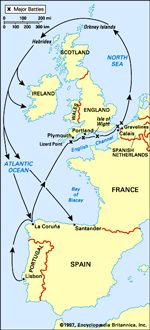
1588 Route of
the Spanish Armada

1588 Routes of the Spanish Armada (USMA)
Elizabeth I —
Short Biography
1533 September 7 - Birth at Greenwich, England
1547 Death of Henry VIII; Edward VI becomes king
1553 Edward VI
dies of tuberculosis; Mary becomes Queen of
England
1554 Imprisonment in Tower of London
1558 November 17 - Queen of England
1588 Defeat of the Spanish Armada
1603 March 24 - Death at Richmond, Surrey, England
Here is
 Elizabeth I's
timeline. Elizabeth I's
timeline.
And here are the maps:
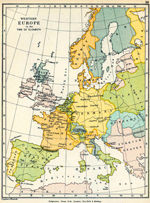
Map of Western
Europe in the Time of Elizabeth
Click map to enlarge

SPANISH
EMPIRE UNDER PHILIP II
Click map to enlarge.
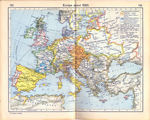
1560 Europe
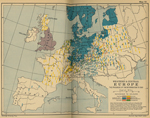
1560 Europe -
Progress of the Reformation
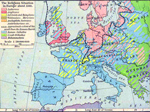
1560
Europe - Religion
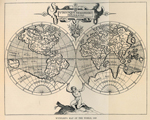
1598 World Map
More History
|